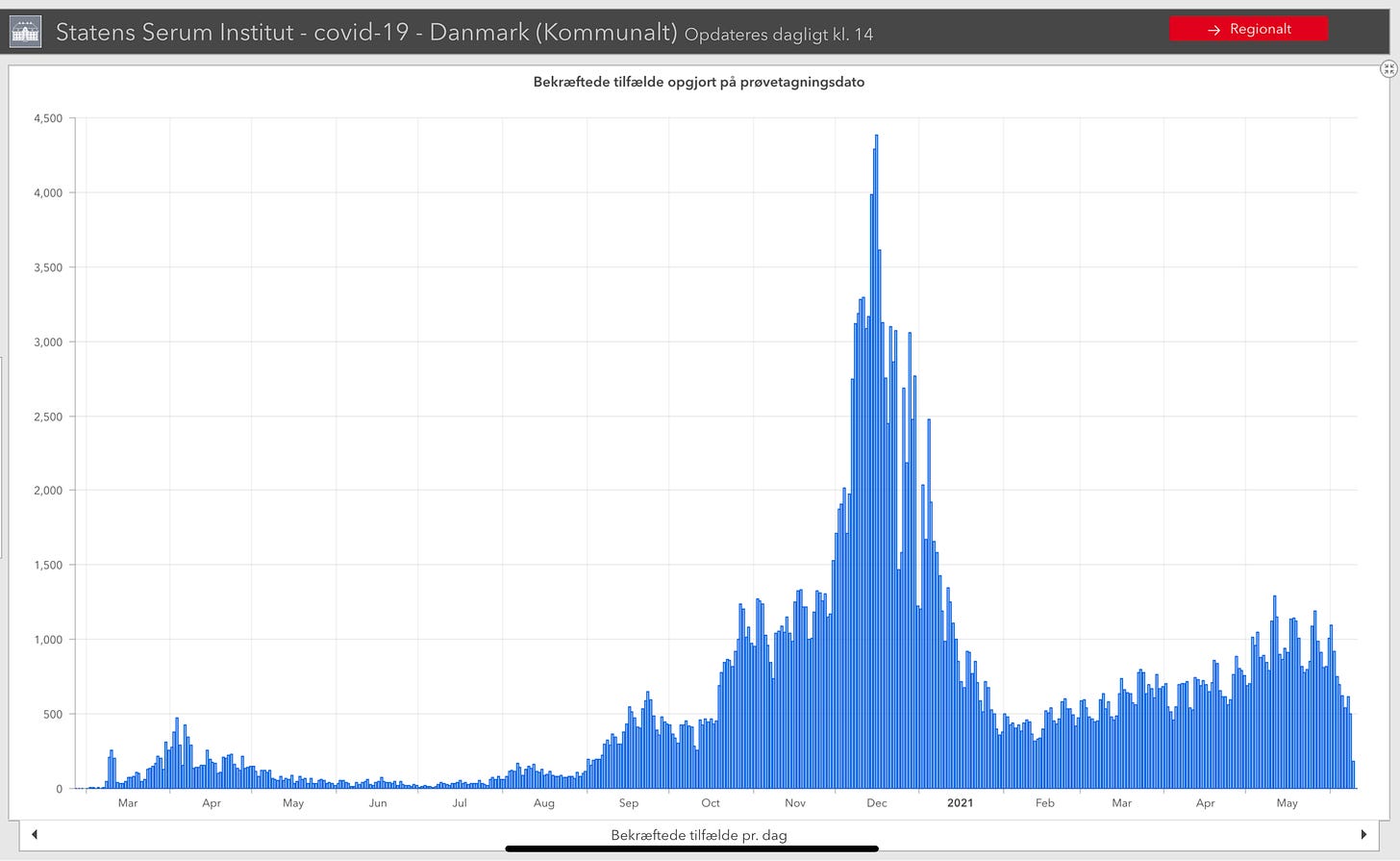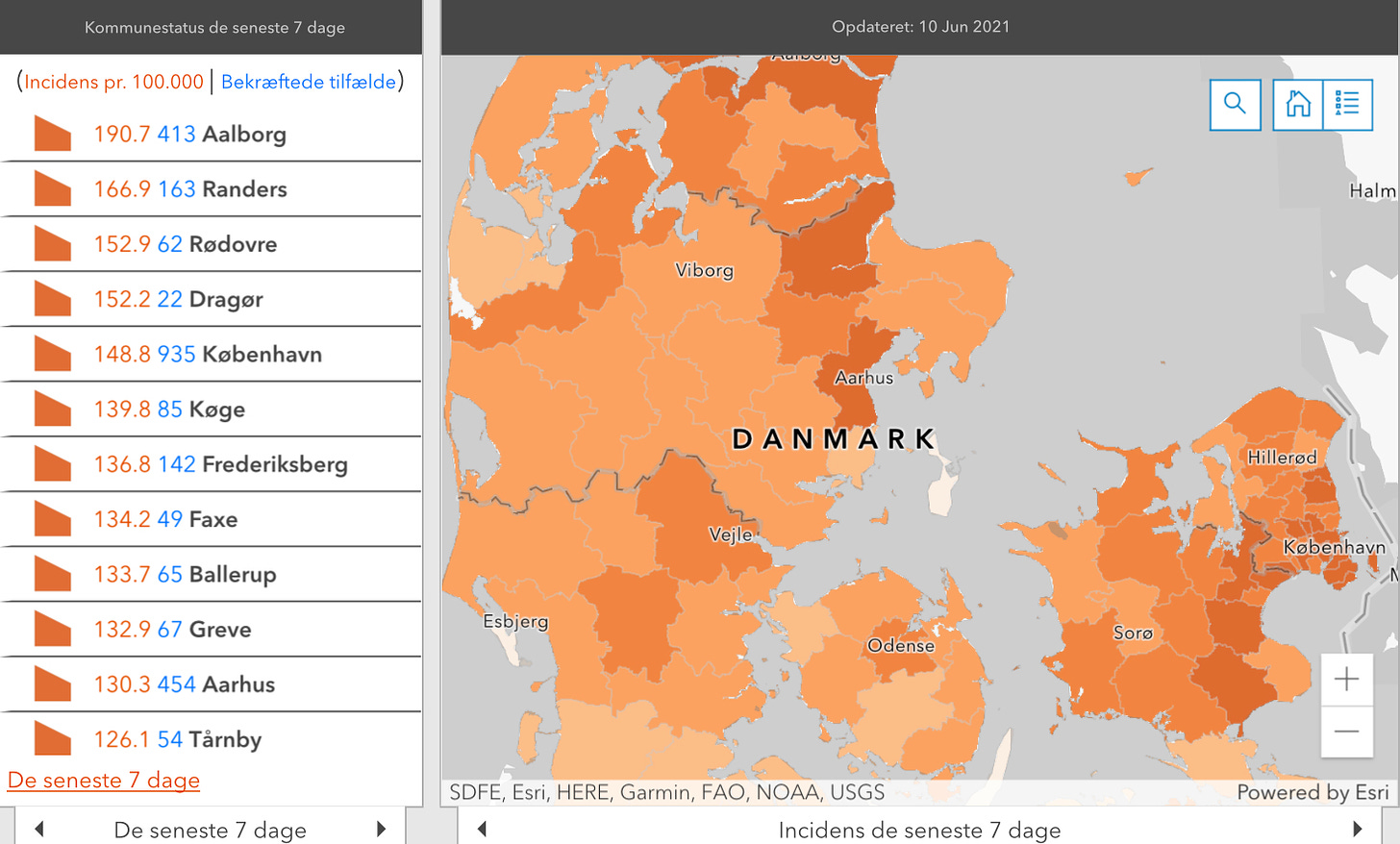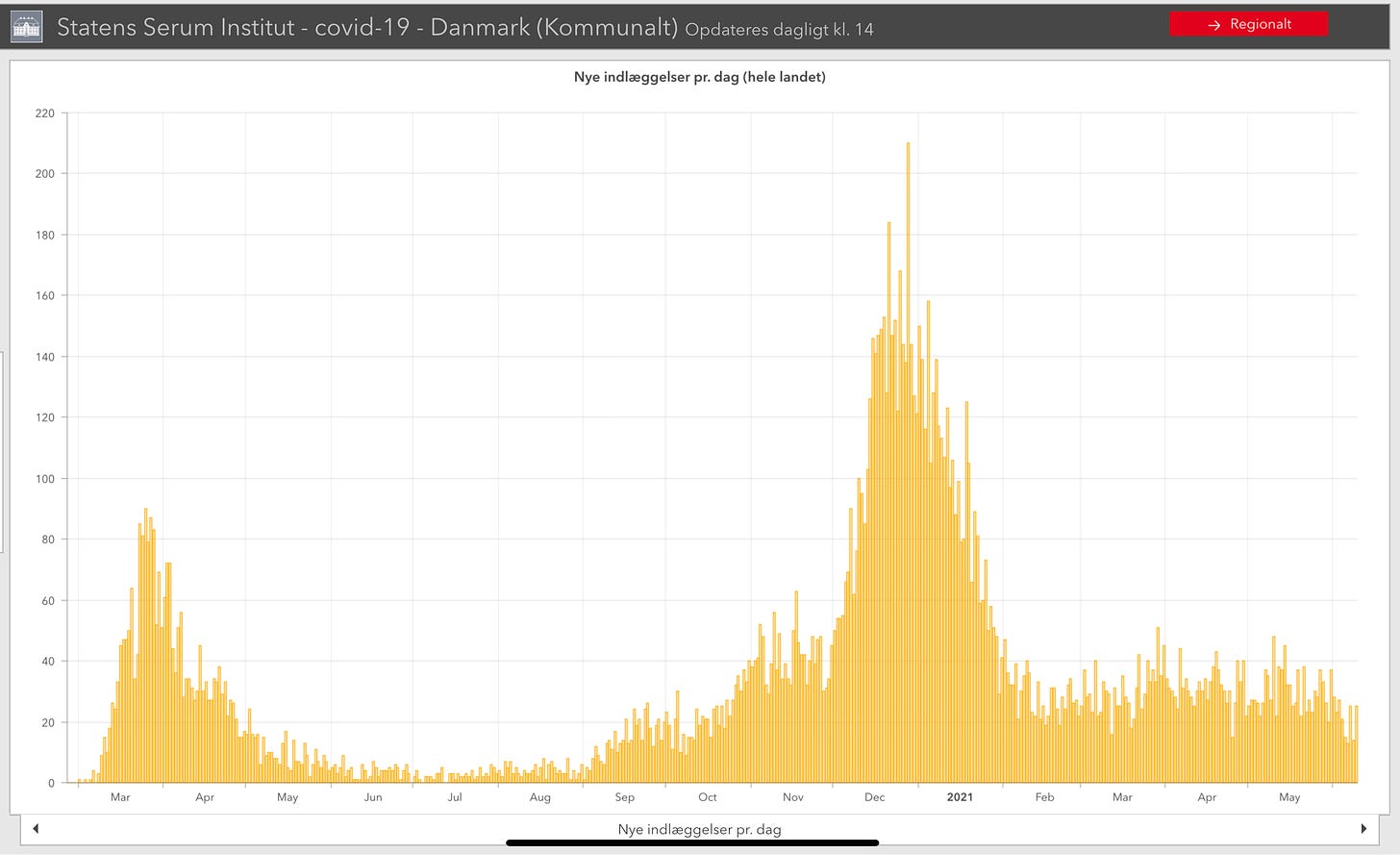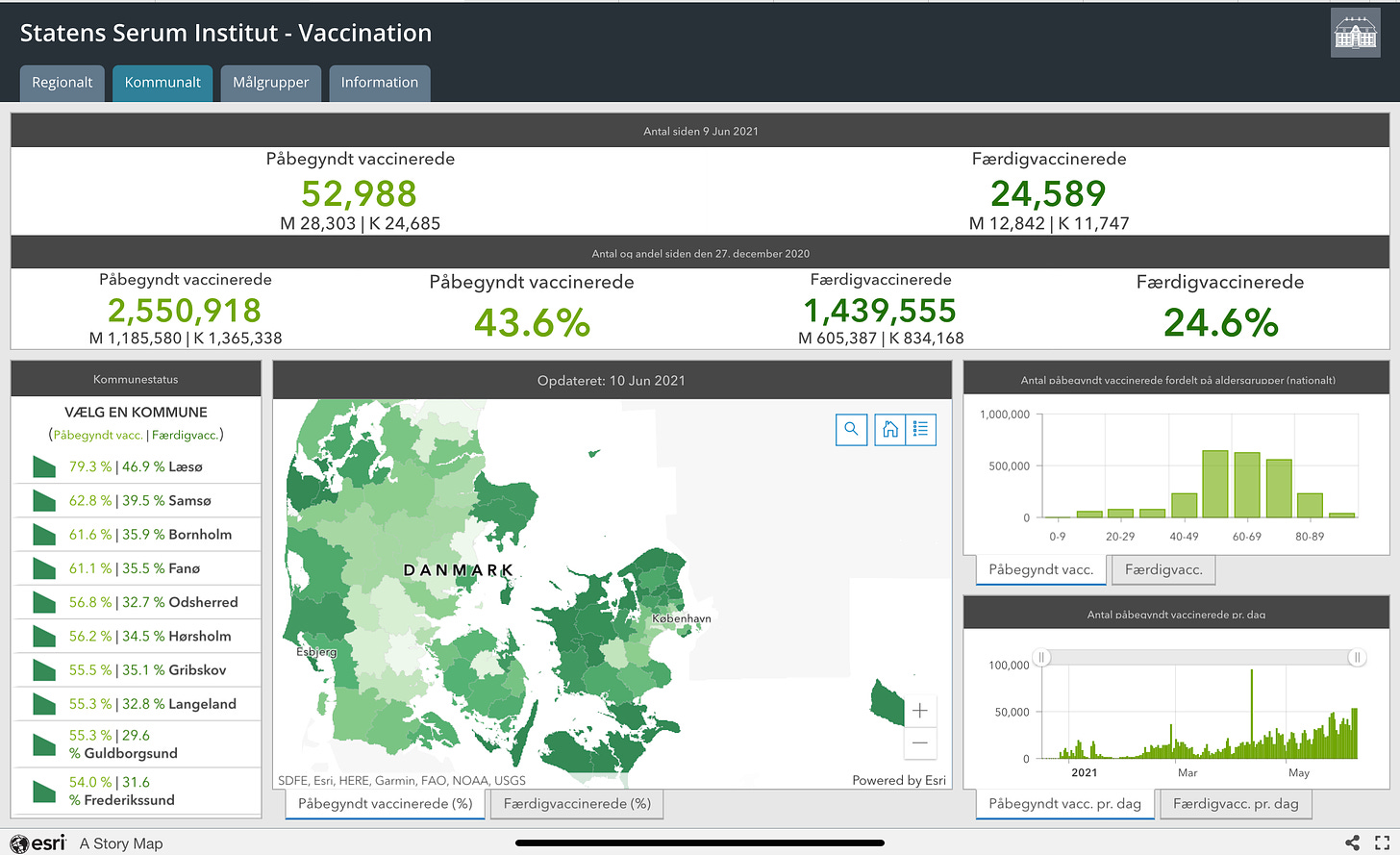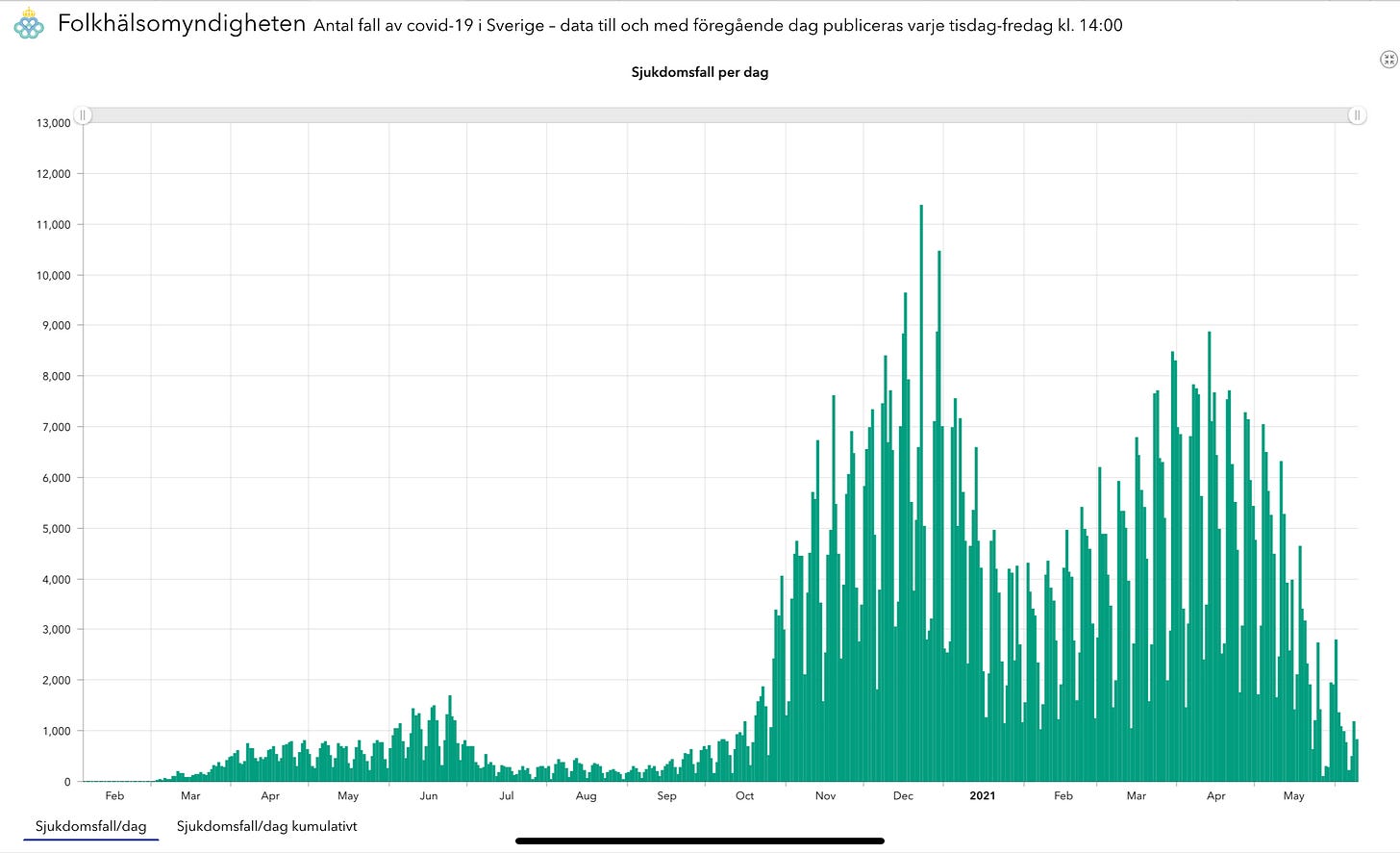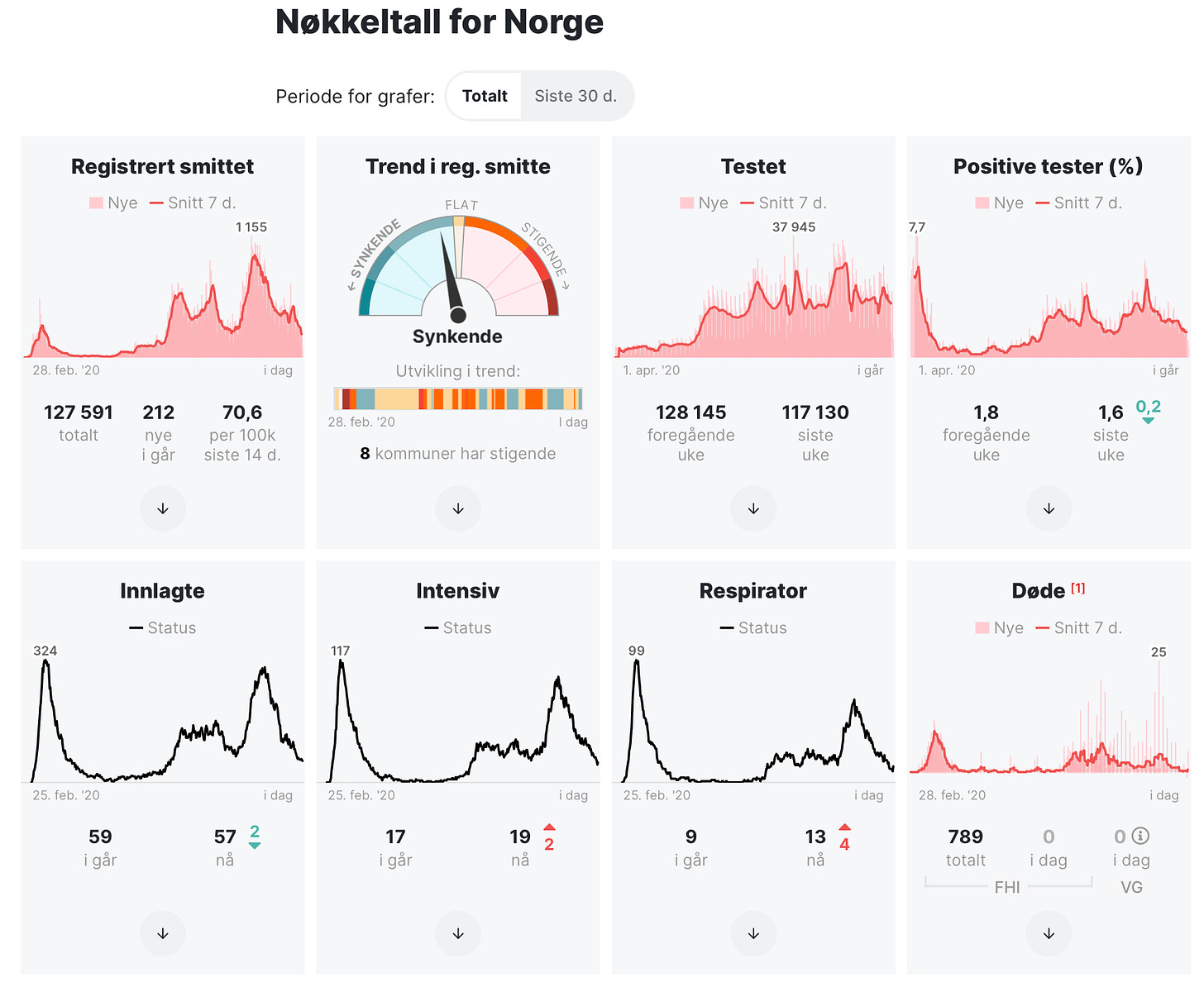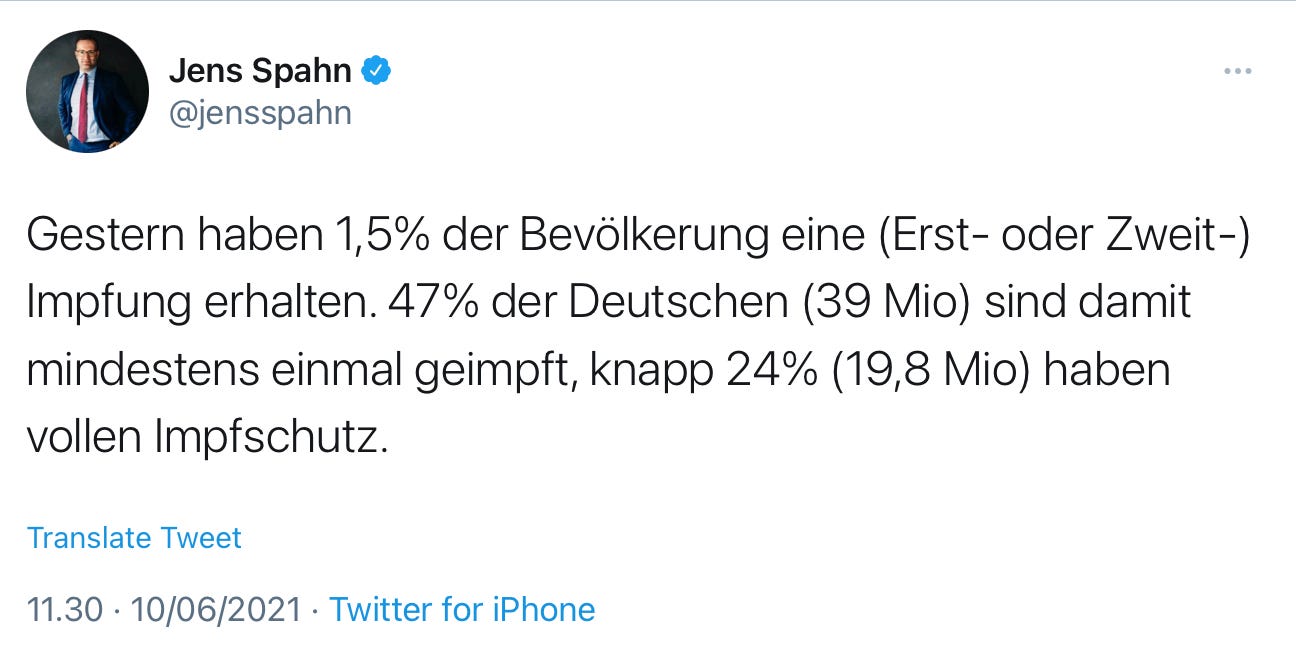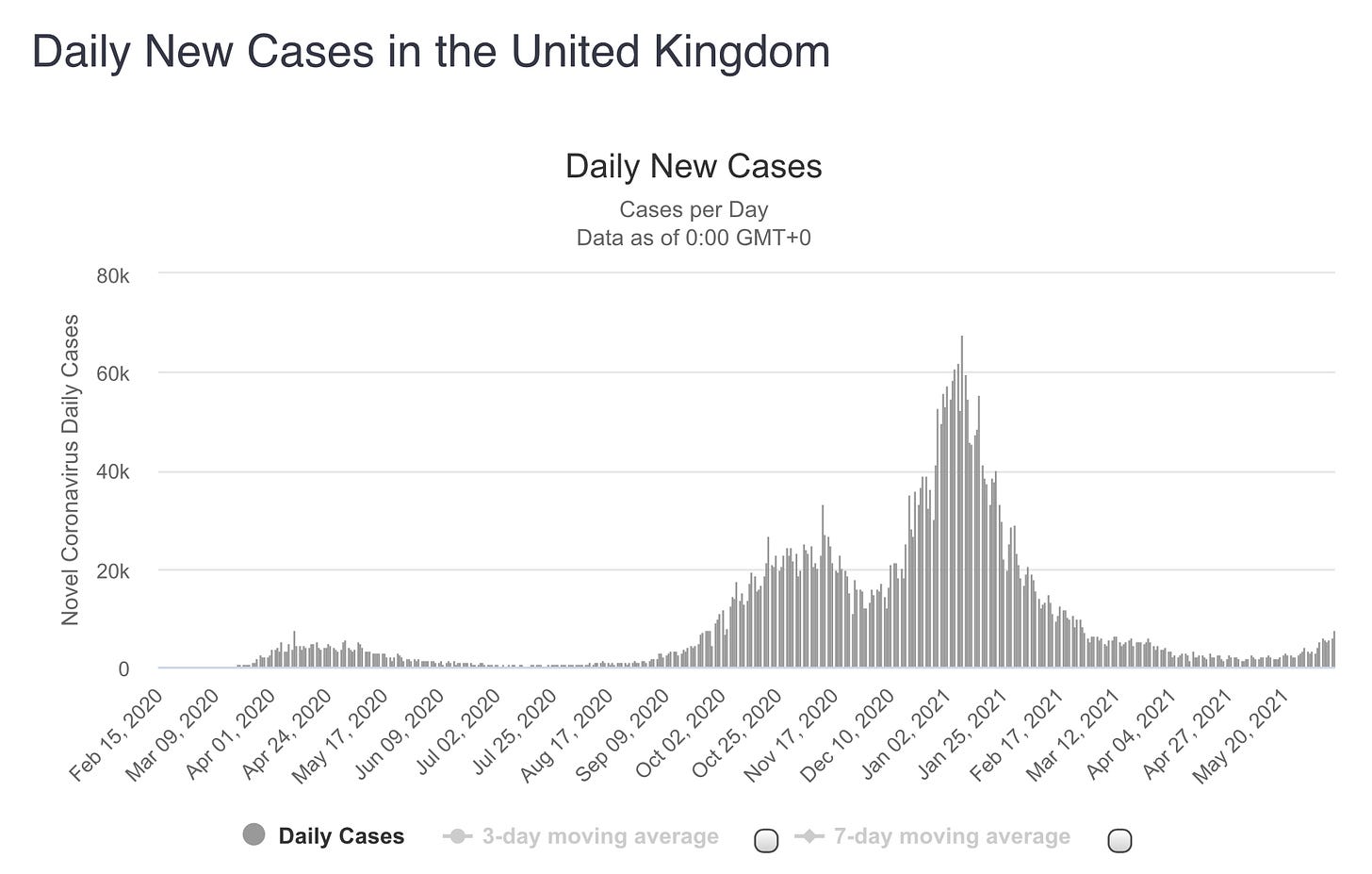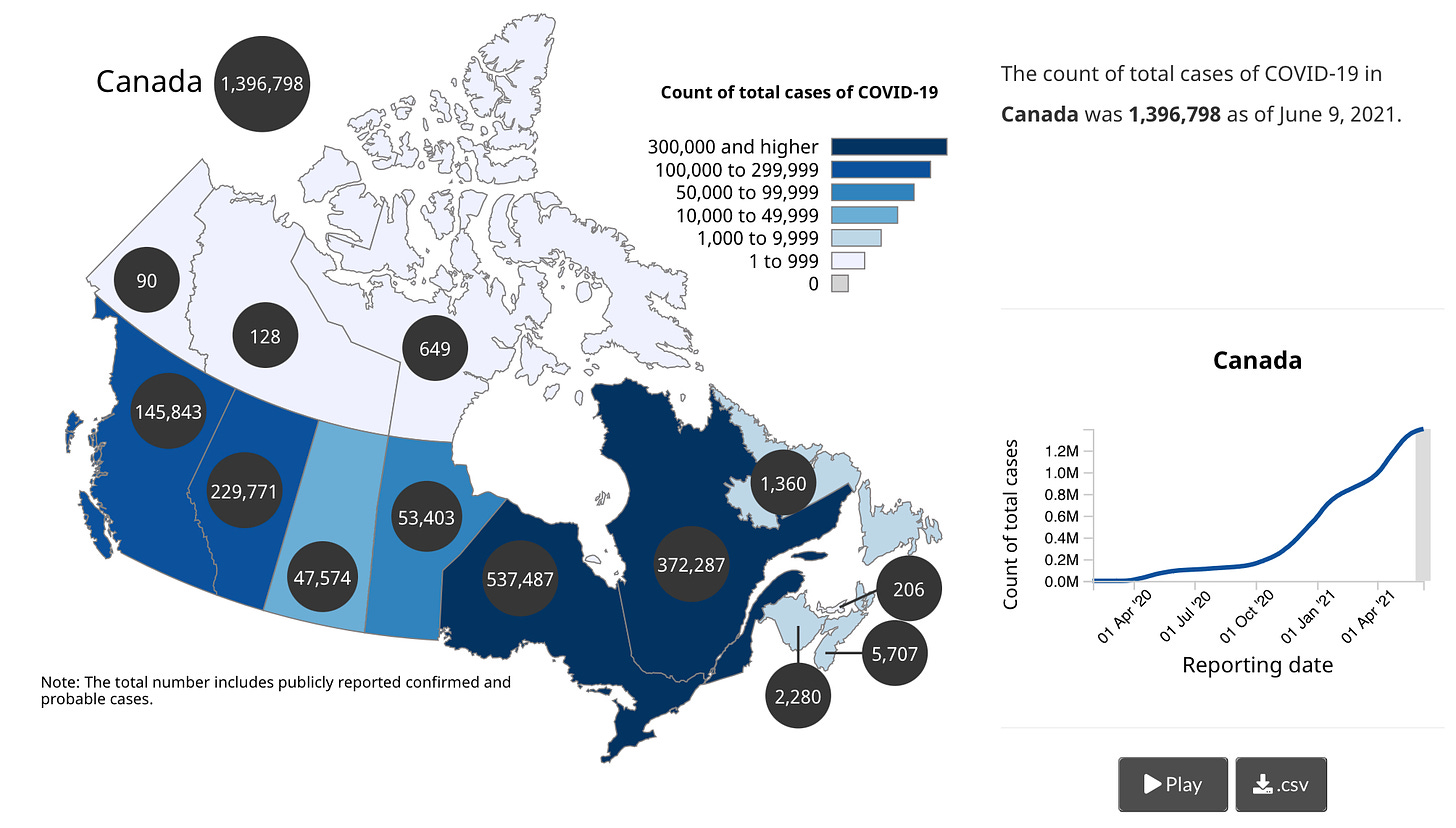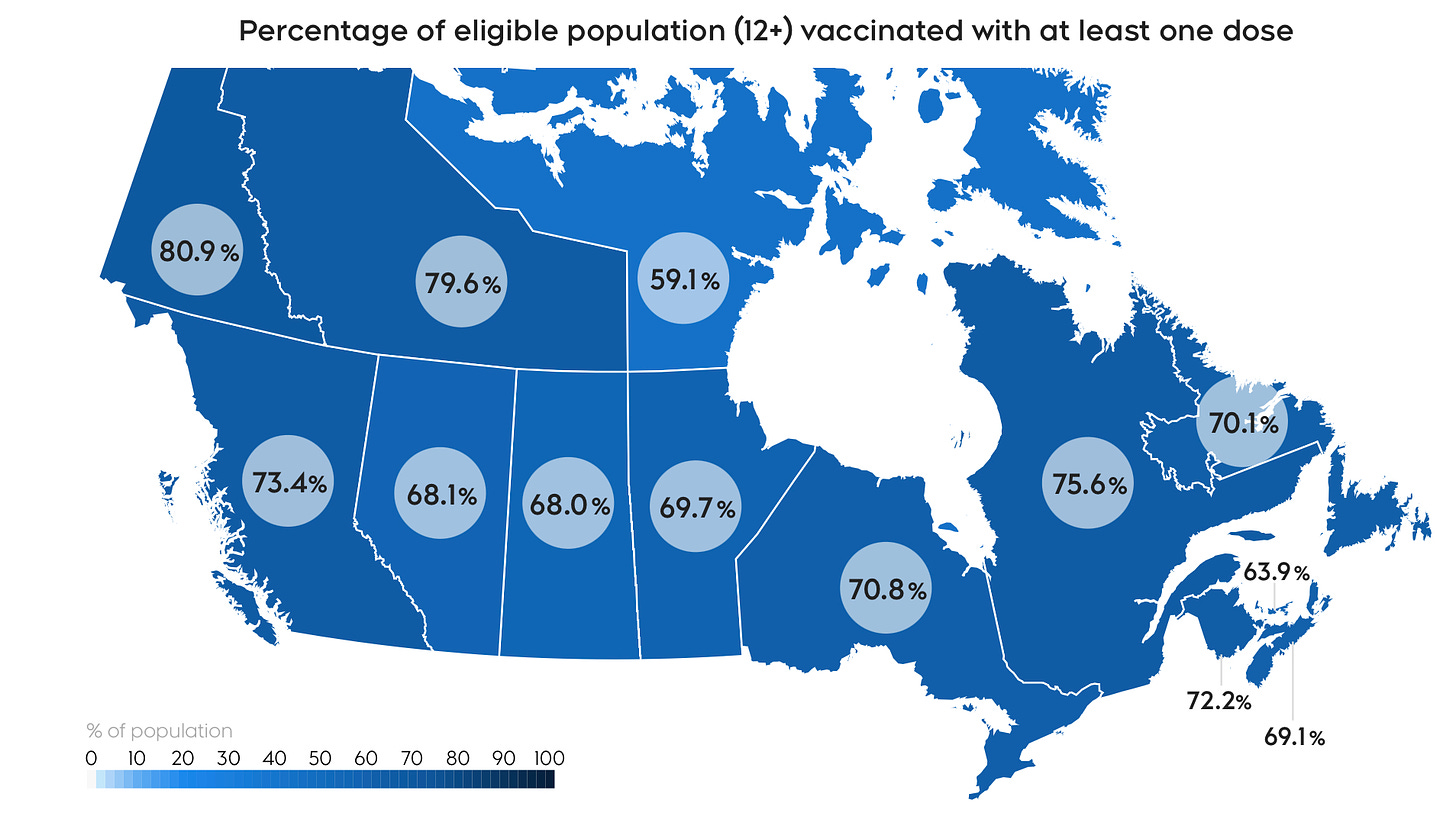The Evening Report - June 10th
As Denmark seeks to return to normal there are plenty of warning signs
🇩🇰
In a press conference today, Denmark’s Health Minister Magnus Heunicke made an appeal to young people, and their parents to get vaccinated. He says parents can help their kids log in and set a vaccination appointment.
Heunicke also said the epidemic situation in Denmark is in such a good position and hospitalizations are at such a low point that there is now a surplus of medical equipment used to treat COVID patients. He says a task force has been struck to see if any of it can be donated to other countries with a more urgent need.
-
The Danish government is going to begin lifting virtually all COVID restrictions, beginning with removing almost all mandates to wear masks and visors on Monday (more on that HERE). The move to abandon masks has the support of the Director of the National Health Board. Soren Brostrøm says with so many people now vaccinated mask use isn’t so critical. That said, he still recommends wearing a mask or visor in certain situations.
If you have symptoms.
If you are ill.
If you have COVID.
If you have been in close contact with someone who has corona and needs to be tested, even if you have been vaccinated.
Wearing a mask on public transit is still required but today Brostrøm clarified a mask is not required if you are seated on public transit.
“In public transport, it is our recommendation that we can take off the mask when we sit down, but should keep it on when we walk or get up, until after the summer, when more people have been vaccinated. When we are to be tested, face masks are also still relevant, and if you have symptoms, or are infected, and especially if you have to go out, you should of course also continue to wear face masks so that you do not infect others.”
-
As the Danish government charts a return to near normal, the Director of the Staten Serum Institut is waving a caution flag.
Henrik Ullum says while the situation is much improved, the pandemic cannot just be cancelled. He emphasizes the coronavirus is still here and still presents a clear and present danger.
"It's going really well, but the epidemic is just dormant. In fact, we have more infected and more hospitalized every day right now than at this same time last year. If we drop all restrictions we therefore risk that some of the many who are currently waiting to be vaccinated against COVID19 risk becoming infected while they wait, and that will be super pity. There are also many who have not yet received the full protection with two doses.”
In particular, Ullum is worried about the Delta variant (B.1.617.2). He says it is the most infectious mutation yet and it could quickly become the dominant strain here, as it did in the UK. He says the more we keep it at bay, it buys time to get more people vaccinated, making it that much harder to spread.
-
And then there were just two. The director of the National Health Board Søren Brostrøm says the Danish vaccination program will have to rely on the Pfizer and Moderna vaccines to get the job done.
Brostrøm says they initially had high hopes the Curevac vaccine would play a major role, along with Pfizer, Moderna, AstraZeneca, and Johnson & Johnson. Now, he says, they can no longer count on Curevac getting approved in time to make any difference.
“We have to face the fact that we have to roll out our vaccine program with the two vaccines we have. Therefore, an updated vaccine calendar will be available soon, but it does not make much difference. With the two vaccines, we can finish with everyone over the age of 16 in September.”
AstraZeneca and Johnson & Johnson were removed from the state vaccination program due to concerns over rare but potentially deadly side effects. Both are now available through an alternate vaccination scheme run by a private provider. But Health Minister Magnus Heunicke has asked the health board to reassess its decision to speed up the inoculation campaign. Next week, the health board will present its new assessment.
-
Denmark is reporting 475 COVID infections and two more coronavirus deaths in the last day.
Yesterday there were 533,125 total corona tests done, 107,043 PCR and 426,082 rapid, for a (PCR only) positivity percentage of 0.44%.
Another promising sign of an improving epidemic posture as Denmark’s infection curve heads downward. There now no kommunes in the country with infection rates above 200 per 100,000 residents.
COVID hospitalizations (120) edged downward (-2) while the number of infected in an ICU (22) also dropped (-5) and of those the number of people on a ventilator (16) inched down (-1).
On the vaccination front, to date 2,550,918 1st dose vaccinations (43.6% of the population) have been administered while 1,439,555 people (24.6%) are now fully vaccinated.
Yesterday there were 77,577 total vaccinations done marking a 3rd straight day daily vaccinations were over 70,000.
The Danish Health Authority has updated rules on close contacts and isolation for those who are fully vaccinated or who have previously had COVID. Fully vaccinated people and those who have had COVID and recovered no longer have to self-isolate after contact with an infected person. But they still need to get tested on the 4th and 6th day after contact. People with a previous infection less than 12 weeks previous don’t have to get tested.
Deputy Director of the National Board of Health Helene Probst:
“The likelihood of vaccinated and previously infected people being infected with COVID is small. Therefore, there is also no reason for them to go into self-isolation if they have been in close contact with an infected person.”
There is a caveat though. If the close contact has a particularly contagious variant only fully vaccinated people can avoid having to isolate. Someone who is not vaccinated but has had a previous infection must self-isolate.
🇸🇪
Sweden has added 831 infections and three more corona deaths since yesterday’s update. The Swedish Public Health Agency is still warning to take the numbers with caution over possible hacking attempts of its infectious disease database, SmiNet. The database was taken offline two weeks ago today.
To date 4,046,103 1st dose (49.4% of the population) and 1,991,440 2nd vaccine doses (24.3%) have been administered.
-
The Swedish Public Health Institute says it has identified what it called an “increased number” of the concerning Delta variant (B.1.617.2). The agency says it is reviewing infection control measures nationally and increasing measures in the regions of n. It says in those two regions “an increasing number of cases” of Delta variant infections have been found. The agency is saying exactly how many infections of the variant have been confirmed.
One of the things the public health agency is doing to be more vigilant is to increase sequencing of positive COVID test samples. To date, Sweden has relied on random sampling of positive infections.
While providing no specifics to the situation it is dealing with Folkhälsomyndigheten says plans for a “return to a more normal situation” will not be affected.
-
Sweden is reporting that vaccination rates among “foreign-born” residents is increasing. Studies in Sweden, and other Nordic countries have found that immigrant populations are at higher risk of COVID but also being vaccinated in much lower rates than native Swedes.
The Swedish Public Health Agency is tracking vaccination by country of birth and says for those aged 60 to 64, vaccination rates for “foreign-born” residents have increased from 59% to 67%. The agency says people born in Africa outside North Africa have the lowest vaccination coverage. But even there, vaccination rates have increased from 49% to 61%.
During the same period, native Swedes have seen vaccination rates increase from 83% to 88%.
The agency says it is not just country of birth, but income and education levels also seem to impact vaccination rates. Those with higher incomes and more education, regardless of country of birth, are getting vaccinated in higher numbers than those with low incomes and no post-secondary education.
-
It was a no-show this winter for Sweden’s usual influenza season. The Swedish Public Health Agency says other “usual” winter viral diseases outbreaks like calicivirus (winter vomiting disease) also didn’t show up. The agency says the pandemic and resulting COVID restrictions and next to no global travel are the reason.
Agency Epidemiologist AnnaSara Carnahan:
“What we have seen this year is what we would call a historic non-season. Improved hand hygiene, the fact that we have met fewer people and that both children and adults have stayed at home to a greater extent when they have had symptoms has been of great importance.”
To put it in context, the agency says an usual winter would see up to 14,000, laboratory-verified influenza cases. This winter there were 29, a record-low number.
🇫🇮
Finland has registered 93 new infections and had no new corona deaths since yesterday’s update.
To date 2,721,652 1st dose vaccinations (48.8% of the population) have been administered while 660,971 people (11.9%) are now fully vaccinated.
-
Finland has adjusted the rules of entry for fully vaccinated travelers and those who have had COVID and recovered. Fully vaccinated travelers who have had a second dose no less than two weeks previous, people who had COVID within six months and who have one vaccine dose, and those who have had one vaccination dose no less than two weeks previous are all exempt from mandated testing upon arrival.
Sometimes border officials may ask for contact information to ask that you be tested 72 hours after arrival as a secondary screening.
🇳🇴
Norway has added 197 infections and had no new virus deaths since yesterday’s update.
COVID hospitalizations (57) have dipped (-2) while the number of people in an ICU (19) has crept up (+2) and of those the number on a ventilator (13) has also increased (+4)
To date 35.04% of Norwegians have had one vaccine dose while 23.54% have had both.
-
In 2020, Norway recorded the highest number of drug overdose deaths in 20 years. According to the Norwegian Institute for Public, there were 324 overdose deaths last year. You have to go back to 2001 for a worse year for overdose deaths, with 441 fatalities.
NIPH’s Linn Gjersing says extremely strong heroin may be one reason for the deadly spike, noting drug seizures last year finding heroin three to four times more potent than anything seized before. The other reason could be the pandemic.
“In 2020, many municipalities had to introduce extensive restrictions and closures as a result of the corona situation. These restrictions have probably also affected people who are at risk of drug-induced deaths.”
She notes regions that saw the most overdose deaths last year were also the ones hit hardest by COVID outbreaks.
The overdose deaths were largely among those using heroin, morphine, codeine, oxycodone, and other opioids.
🇩🇪
Germany’s vaccination effort continues to rocket along. Health Minister Jens Spahn says enough inoculations were administered yesterday to account for 1.5% of the country’s population. Spahn says 39 million people in Germany (47% of the population) now have one vaccine dose while 19.8 million (24%) are fully vaccinated.
🇪🇺
European Union Commission President Ursula von der Leyen says the EU passed major vaccination milestone today.
🌎🩺
While countries like Denmark plot a return to normal, the World Health Organization is sounding a warning. The WHO said today that vaccination rates in Europe are insufficient to prevent another COVID wave. The global health agency urged E.U. countries to maintain coronavirus restrictions.
WHO European Regional Director Hans Kluge:
"Although we have come far, we have not come far enough. Vaccination coverage is far from sufficient to protect the region from a resurgence. The distance to go before reaching at least 80% coverage of the adult population is still considerable.”
He urged European nations to avoid the mistake of last summer of easing restrictions too soon, allowing for another infection wave.
"Over the course of last summer, cases gradually rose in younger age groups, and then moved into older age groups, contributing to a devastating resurgence, lockdowns and loss of life, in the autumn and winter of 2020.”
He said EU countries need to take that lesson to heart and expand testing, contact tracing, and vaccinate as fast as humanly possible.
🇬🇧
The Delta variant continues to drive infections back upward in the UK, one of the planet’s most vaccinated countries. Infections, hospitalizations, and deaths over the last seven days are all increasing.
Today the UK reported 7,393 new cases and 7 new deaths.
🇨🇦
Canada reported 1,388 infections and suffered another 32 deaths yesterday.
So far the Canadian mass vaccination campaign has administered 23,828,440 1st vaccine doses (62.70% of the population) while 3,416,163 people (8.99%) are now fully vaccinated.
In Ontario today Health Minister Christine Elliott tweeted “Ontario is reporting 590 cases of #COVID19 and over 31,400 tests completed. Locally, there are 130 new cases in Peel, 114 in Toronto, 61 in Waterloo, 38 in Hamilton and 32 in York Region. As of 8:00 p.m. yesterday, 10,627,469 doses of the COVID-19 vaccine have been administered, including 182,350 doses administered yesterday.“ There were also 11 deaths. Ontario is accelerating second dose vaccinations especially in hot spots where the Delta variant is active.
Quebec reported 189 infections and two deaths.
In Atlantic Canada, Nova Scotia recorded 15 new infections. Newfoundland and Labrador had five. New Brunswick three.
Manitoba saw another 250 infections yesterday and two more deaths. To encourage people to get vaccinated the province is offering millions of dollars in prizes and scholarships. Manitoba has tabled a reopening plan tied to vaccination rates. 70% of the population with one dose is the first target triggering some easing of restrictions.
There were 57 infections and one death in Saskatchewan yesterday.
Alberta registered 313 new infections and five more virus fatalities.
B.C. reported 148 infections and three more corona deaths yesterday.




